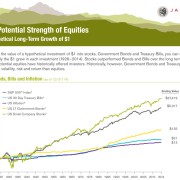Globally Diversified Bond Portfolio – Independent Press – 08/03/11
The Independent Press
Money Matters – Skloff Financial Group Question of the Month – August 3, 2011
By Aaron Skloff, AIF, CFA, MBA
Q: Although my stock portfolio is globally diversified, my bond portfolio is exclusively invested in the U.S. What are the advantages and disadvantages of a globally diversified bond portfolio?
A: The Problem – A Geographically Concentrated Bond Portfolio.
Although the U.S. bond market is the largest in the world and deserves representation in many investors’ portfolios, record levels of federal debt combined with the risk of rising interest rates has increased the risk of U.S. bonds. Bond prices generally move in the opposite direction of interest rates. U.S. federal debt as a percentage of Gross Domestic Product (GDP) has risen from less than 33% in 1980 to approximately 100% today – levels not seen since the post World War II era. Investment concentration in any one country can wreak havoc on a portfolio.
The Solution – Globally Diversified Bond Portfolio.
The same way you would not invest your entire stock portfolio in one company (remember Enron and American International Group?) you would not invest your entire bond portfolio in one country – even if that country was the U.S. If the U.S. or any one country you were solely investing in experienced a severe economic downturn your investment portfolio could be irreparably damaged. The advantages of a global bond portfolio include potentially higher returns and potentially lower risk. The disadvantages of a global bond portfolio include potential currency fluctuations and potential political instability.
Advantage of Potentially Higher Returns. For the 10 year period ending June 30, 2011, the Barclays Capital Global Aggregate Bond Index (an unmanaged index of global investment-grade fixed-income securities) returned 7.4% annualized versus the Barclays Capital U.S. Aggregate Bond Index (an unmanaged index of U.S. investment grade fixed-income securities), which returned 5.7%. The outperformance of the Barclays Capital Global Aggregate Bond Index was due in part due to the long term trend of the weakening U.S. dollar and higher yields offered outside the U.S. Many international countries offer potentially higher returns due to faster economic growth, relative to the U.S. The market has historically demanded higher yields from foreign debt issuers than U.S. issuers, due to their perceived higher risk.
Advantage of Potentially Lower Risk. The U.S. weighting in the Barclays Capital Global Aggregate Bond Index has declined from approximately 50% in 2000 to approximately 37% in 2010. A bond portfolio with a U.S. weighting that is greater than 37% portfolio can be classified as riskier than a portfolio with a 37% weighting, relative to the Barclays Capital Global Aggregate Bond Index. If the U.S. experiences relatively higher inflation expectations, increased U.S. government debt levels and/or sustained account deficits, the U.S. dollar is likely to further decline. A portfolio of international bonds denominated in local currencies would likely protect the purchasing power of U.S. dollar investments.
Disadvantage of Currency Fluctuations. Although the U.S. dollar has been experiencing a decade long decline in value as other countries’ economies and currencies outperform the U.S., the trend could reverse. If the U.S. dollar were to appreciate, investments in international bonds denominated in local currencies would likely depreciate.
Disadvantage of Political Instability. Based on U.S. politicians’ approach to the 2011 federal debt ceiling, many investors would classify the U.S. as politically unstable. That said, the U.S has been as stable as the Rock of Gibraltar when compared to other countries over the last 50 years. For example, political instability in Russia and Argentina contributed to their defaults in 1998 and 2001, respectively. Of course, the outperformance of the Barclays Capital Global Aggregate Bond Index discussed above is net of any defaults and is presented in U.S. dollars.
Action Step – Globally Diversify Your Bond Portfolio.
A globally diversified bond portfolio can increase returns and reduce risk. With the U.S. facing political and economic uncertainty, a globally diversified bond portfolio can be a ballast in the storm.
Aaron Skloff, Accredited Investment Fiduciary (AIF), Chartered Financial Analyst (CFA), Master of Business Administration (MBA) is CEO of Skloff Financial Group, a Registered Investment Advisory firm based in Berkeley Heights. He can be contacted at www.skloff.com or 908-464-3060.











